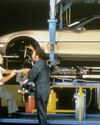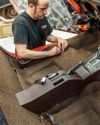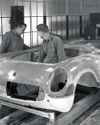Rebuilding a 1963-’68 Alternator and Adding a Solid State Regulator

When Chevrolet introduced the redesigned Corvette in 1963 one of the new features was the Delcotron alternator that replaced the venerable generator. Dubbed the 10 DN, the externally regulated Delcotron was GM’s new charger of choice through 1968, when the internally regulated alternator was introduced.
In operation, alternators and generators do the same job, they convert mechanical energy into electricity to keep the battery charged. They do it differently but both rely on the relationship between electricity and magnetism. When electricity is flowing through a wire, there is a small magnetic field generated around the wire, and when a wire moves through a magnetic field, a small amount of current, or electricity, is generated in the wire. Creating electricity is simple a matter of moving one past the other continuously. A generator does it by moving a bundle of wire loops, called an armature, inside a fixed magnetic field. An alternator spins a rotor, or a series of electromagnets, inside a stator made up of multiple wire loops. The voltage regulator controls the strength of the magnetic field, thereby controlling the output of the alternator.
This story is from the January 2017 edition of Vette.
Start your 7-day Magzter GOLD free trial to access thousands of curated premium stories, and 8,500+ magazines and newspapers.
Already a subscriber ? Sign In
This story is from the January 2017 edition of Vette.
Start your 7-day Magzter GOLD free trial to access thousands of curated premium stories, and 8,500+ magazines and newspapers.
Already a subscriber? Sign In

When Originality Is The Problem, Restomod Is The Solution
An artistic amalgamation that blends modern upgrades with classic lines

Building America's Sports Car
When nearly three decades of production ended at St. Louis, Corvette assembly went high-tech in rural Kentucky

COMING FULL CIRCLE
Young man’s hot rod passed down to another young hot rodder

From the Archives
Bred to Race

It's All About The Base!
The standard C8 coupe offers a robust foundation to enable you to build your own special 2020 Corvette

Supersonic
David Gonce’s 1979 Corvette packs plenty of attitude

2019 CORVETTES AT CARLISLE
Fueled by the C8 Corvette, the Corvettes at Carlisle show set a new attendance record in 2019

Rug Doctor
Fresh carpet brings new life to our 1968 Corvette project car

Form And Function
No compromise needed

Building America's Sports Car
Three Corvette assembly plants and a look back at 67 years of production of one red-hot all-American sports car